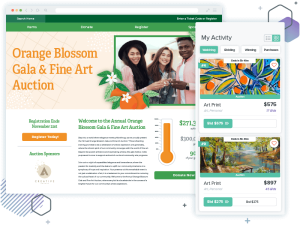The internet—and even phones to some extent—have produced a certain amount of anonymity when it comes to asking for donations and making contributions. You can reach out to donors whom you have never met before, and they can feel moved enough to give their money to your organization. But are you missing out on a more personal way of fundraising?
Sometimes you need to ask for donations in person at fundraising events or other functions. Not only does this help alleviate any miscommunication that can happen with fewer human communication channels, but it also makes it easier for your organization to form more meaningful relationships with your donors.
The issue some people have with asking for donations in person is that it can be a nerve-wracking experience. Not only do you have to successfully pitch your organization’s mission and vision to someone who only has an outsider’s view, but you also must ask that person to contribute monetarily to your nonprofit. It can be a stressful and time-consuming endeavor.
Online fundraising vs. in-person donations
In the digital age, online fundraising has become an essential tool for nonprofits. This fundraising method provides both convenience and the ability to reach a larger audience. Despite these advantages, in-person donations provide unique benefits that digital fundraising can’t fully replicate.
- Building personal connections. When you ask for donations in person, you’re able to build a more personalized connection to your donors. Face-to-face interactions help you to convey your passion and address any concerns directly.
- Increasing trust. Meeting your donors in person can help them see the genuine commitment and dedication behind your cause, which can help increase your donors trust in your organization.
- Receiving immediate feedback. In-person interactions offer your donors a way to give feedback immediately. This feedback can help you gauge your donor’s interest and adjust your approach to secure a donation.
Types of donations
There are a few different types of donations you can ask for in person. Here are three primary categories:
- Cash donations. Cash donations are the most straightforward and common type of donation. Cash funds go directly from your donors to the projects they want to support.
- In-kind donations. In-kind donations consist of goods and services instead of cash. These can include items like office supplies, food, auction items, or professional services to support your organization’s operations.
- Planned donations. Planned donations are arranged in advance and are often part of a donor’s estate planning. Planned donations can be bequests, trusts, or other financial options to provide long-term support for your cause.
Take a look at the following fifteen best practices for asking for donations in person:
- Do research beforehand
- Form a strong relationship before you make your ask
- Meet them where they are
- Remember major gifts can take time
- Tailor your approach for your donor segments
- Practice your pitch or even make a script
- Reach out in a variety of ways
- Bring visual aids and leave-behinds
- Be genuine, direct, and specific
- Know what words to avoid
- Tell good stories
- Be prepared for rejections
- Provide an easy way to donate on the spot
- Say thank you more than once
- Stay in touch post gift
1. Do research beforehand
Most of the time, asking for donations in person can indicate that the individual has the potential to be a major gift donor. While this isn’t always the case, think about the times in the past you’ve had to meet someone in person to ask for a donation. Chances are those meetings weren’t for $25–they were probably for the amount your organization deems as a major gift.
People want to meet in person to get a good feel for your nonprofit and your cause before they write a sizable check. And just like they want to learn more about you, your nonprofit should do what it can to learn more about them.
Depending on your existing relationship with the individual, this research can take a variety of forms. If they are a friend or family member of someone who works with your organization, your research can begin with that person. If they have given to your organization in the past, you can look at their past giving history to get a ballpark estimate of how much you should ask for.
If they have volunteered with your nonprofit previously, determine which events and projects they have given their time to. Knowing what they feel passionate about will help you better tailor your appeal. By completing some simple research before you start a donation appeal, you’ll be better off in the long run.
2. Form a strong relationship before you make the ask
Creating a strong relationship with a prospect goes hand in hand with doing research beforehand. You wouldn’t expect a birthday present from someone you just met, and you shouldn’t expect a donation from a brand new prospect.
Forming relationships with prospects takes time, but the results will be well worth the hours and the patience. Truthfully, you should be forming relationships with your donors and prospects anyway! Donors help your organization’s engine run and having meaningful connections with them will ensure that they continue to support your cause in the future.
When forming relationships with prospects, let them talk about what interests them and what aspects of your organization they would like to support. Instead of over-inserting yourself every time you have a conversation, allow the dialogue to flow between what they can do for your organization and how your nonprofit can effectively utilize the resources they’d be willing to give you.
3. Meet them where they are
This point is twofold. “Meet prospects where they are” can mean:
- Literally meet them where they are (or at least where they’re most comfortable). That could mean heading to someone’s office, the golf course, or meeting them virtually in their living room.
- Metaphorically meet them where they are. If a prospect expresses interest in giving a certain amount, don’t pressure them into giving more. Understand that they’re most knowledgeable about their finances and how to allocate them.
When you meet a prospect where they’re most comfortable, you take a lot of pressure off them. And, while this could mean that you’re more nervous, it helps to put your potential donor’s mind at ease.
It’s also important to remember to make the donation pitch about them. While you’ll definitely talk about your organization, remember that the goal is to get them excited and engaged. Highlight what they can do to help further your cause.
4. Remember major gifts can take time
Patience is key when asking for donations in person! Securing major gifts often requires multiple meetings and ongoing communication because these donations are typically larger and represent a significant commitment from your donor. A big decision like a major donation is one your donor will want to be sure about.
Take your time when meeting up with donors to demonstrate your commitment to your cause and make them more confident in their commitment to supporting you. Outline the impact their contribution can make and provide detailed examples and data to underscore your points.
5. Tailor your approach for your donor segments
Approaching first-time donors differs significantly from engaging with your existing donors. For first-time donors, your focus should be on introducing them to your mission, values, and the immediate impact their contribution can make. Talk to them about your success stories and testimonials to build a connection with your new supporter.
With your existing donors, you should already have an established relationship and an idea of what previous accomplishments you should highlight that they helped you achieve. Discuss any future projects you know they’ll be interested in and offer opportunities for them to continue supporting your cause to foster a sense of partnership and long-term engagement.
6. Practice your pitch
The last thing you want is to go into a meeting with a prospect and forget every point you were going to say. To help alleviate this fear, practice your pitch regularly! While you don’t have to memorize a speech or carry note cards in your back pocket, you should review your pitch several times before making your official ask.
Practice in front of a mirror or with colleagues to make notes of your body language and any nervous gestures. When practicing in front of others, ask them to help you prepare for any kind of answer you might receive from your prospect. While you can hope for a resounding “Yes!” from a prospect when you ask them for a donation, you have to be ready for a range of responses.
7. Communicate in a variety of ways
Even though you’ll be asking for donations in person, it’s always a good idea to talk to prospects using different communication channels prior to and after making the ask.
These methods should include:
Talking to donors in a variety of ways should be a standard practice across the board. It’s especially important when communicating with potential major gift donors who you’ll be soliciting in person.
An in-person meeting can go a long way, but you wouldn’t want to take thirty minutes out of someone’s day when a quick email would suffice. This is especially true if you’ve been hosting typically in-person meetings virtually, because the collective Zoom fatigue is real. Balance is key!
8. Bring visual aids and leave-behinds
Visual aids such as photos, infographics, and videos can help make your appeal more enticing and easier to understand. These tools can illustrate the scope and impact of your work while making your ask more vivid and memorable.
You can also provide your donors leave-behinds like pamphlets or small tokens to serve as reminders of your nonprofit to stay top of mind even after the meeting ends. Personalized materials that reflect your donor’s interests can help motivate your donors and make them feel more connected to your cause.
9. Be genuine, direct, and specific
This is another point that should be standard practice whenever you’re asking for donations in person, but it’s so important that it bears mentioning. Being genuine, direct, and specific not only shows that you’re interested in a prospect or donor contributing to your cause, but it also demonstrates that you’re invested in your cause as well.
People won’t want to give to an organization that you give half-hearted attention to. Additionally, once you actually ask for a donation, don’t be vague. State a specific amount that you can back up with information gathered during your research stage. Directly ask for an amount, but remember to be flexible and let your prospect talk. Keeping the dialogue open will help ensure that you receive the donation you’re asking for.
Finally, let the prospect specifically know what the money would or could go toward. While this should have come up in previous conversations, it’s wise to let them know how you generally plan on allocating the money.
Check out these scripts for requesting donations from first-time donors and from recurring donors:
![Donation Request Script for First-Time Donors: "Jerry, I want to talk to you about [Nonprofit Name] for a moment. Would you be willing to contribute $XXX to our organization? With your assistance, we could fund [Project X], [Project Y], and [Project Z]. [Nonprofit Name] needs more partners like you to help achieve our goals, and we'd greatly appreciate your help."](https://www.qgiv.com/blog/wp-content/uploads/2023/02/2023-Asking-for-donations-in-person-scripts-01-1024x673.png)
10. Know what words to avoid
Wording can have a huge impact on your donor’s willingness to give! Avoid using too much “we” language. Your donors want to know the impact they’re making, so consider replacing “we” statements with “you” statements.
You should also avoid making negative and vague statements. Don’t focus on what you won’t be able to do without a donation and instead tell donors what you can do with a donation. Instead of telling donors what you hope you can do with their contribution, tell them what their contribution can do.
Use language that conveys the significance of their contribution and how it enables transformative change. For example, instead of using “donation” over and over again, words such as “investment,” “partnership,” and “legacy” can resonate more strongly with donors and highlight the meaningful role they play in your organization’s mission.
11. Tell good stories
The stories you tell at your nonprofit are instrumental to asking for donations in person. Share stories of the people that your nonprofit has helped when you make the ask. This can inspire people to dig deeper and make larger gifts to support your cause.
People give to benefit others, which is why it’s imperative that you have good stories in your fundraising toolkit when you make your asks. If you’re adding a visual aid to your presentation, consider creating a video testimonial from people you’ve helped
12. Be prepared for rejections
While you may think that supporting your nonprofit’s cause is the most important thing in the world, you must acknowledge that not everyone will think this way. In fact, you have to be prepared for people to say no, maybe, or anything in between.
Of course, this doesn’t mean you should immediately give up. Instead, take a step back and evaluate your asking process. Adjust and tweak as you see fit and try again. Having said that, don’t pester prospects until they’re annoyed. If they seem uninterested in giving money, offer other ways that they can give to your organization, either through volunteer time or by attending events.
13. Provide an easy way to donate on the spot
Make it convenient for your donors to contribute immediately by having multiple ways for your supporters to give on the spot. Besides cash and checks, provide your in-person donors the options to give with credit cards, PayPal, or direct bank transfers to cater to different preferences.
The easier they can donate, the more likely they are to do so, ultimately increasing the chances of a successful ask. With multiple donation options, your donors can give without needing to remember their checkbook.
14. Say thank you more than once
If you do receive a donation, make sure you’re following up with donors and thanking them.
This does not mean you say “Thanks!” after the ask is done and hope that covers it. You need to show donors that you sincerely appreciate their interest in and dedication to your organization:
- Send a personalized thank-you letter after the donation has been made.
- Stay in touch via email and social media.
- Highlight your donors in your annual report or somewhere on your website.
- Continue to meet donors in person when possible and thank them for their support.
By demonstrating your appreciation and highlighting your donors’ generosity, you are deepening your relationship with them. This can lead to more donations down the line.
15. Stay in touch post gift
Once you’ve secured the donation, you want to make sure that the donor continues to support your nonprofit organization. You can accomplish this by staying in touch after the gift is made. Be sure to have a communications plan in place for talking with donors after they’ve made their gift.
You can encourage donors to give again and again by reaffirming the impact their gifts have had on those you serve. Be sure to share impact stories with donors regularly so that they know how their contributions have made a difference. Encourage your donors to stay involved by signing up for your newsletter or taking some other non-donation action that benefits your cause. This can help get donors in the trenches working alongside you to achieve your goals. Getting donors invested like this can get them to give larger gifts or give again after their initial gift.
Final thoughts
Asking for donations in person creates closer and more meaningful connections between nonprofit professionals, donors, and prospects. By following these fifteen best practices, you’ll be better poised to make your ask for donations in person and raise more money for your organization’s cause.
Additional resources
- Need to brush up on your donation requesting skills in general? Never fear! Check out this blog post on asking for donations to get started.
- Looking for tips to help you plan your giving campaign? Check out this guide to planning your fundraising campaign.
- Still have questions? Be sure to consult this fundraising FAQ resource for more information on all things fundraising. Then sign up for the free Fundraising Boot Camp email series!



